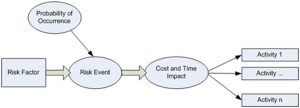
When building a Monte Carlo simulation model in @RISK for project risk analysis, we can incorporate a risk register through risk factors. Risk factors are more concrete abstractions of risk and define situations that can be individually assessed with a limited amount of information.
Risk factors affect a project through the occurrence of events that disrupt the development of an activity or a group of activities causing variations from the expected duration and cost estimates. This means that risk factors do not affect project activities directly, but do so through conditional consequences given that a risk event has occurred as shown in the figure below.

The concept of risk factors is similar to one of common causes that is widely used in fault tree analysis in other engineering applications. The fact that a group of activities is affected by a common risk factor will indirectly induce correlation when consequences of that risk materialize. Risk factors are an alternative to deal with correlation between project activities. When a project is affected by several risk factors they are grouped in a risk register.
The main advantage of using risk factors is that we can make use of causal relationships to relate the occurrence of a certain risk event with its consequences on project activities. One example of the application of a risk factor for a construction project is the risk of inclement weather; if inclement weather occurs, it delays not only the execution of open-sky activities that are scheduled at that time but also could affect the productivity of labor and machinery incurring in increased costs.
One of the main problems with risk factor models used in project risk analysis is that risks affecting project performance are considered mutually independent; moreover it examines risk impact of each risk factor separately. In reality, risk factors are very often interdependent and their impact varies simultaneously with a compounding effect. This interdependency can be modeled using event trees in PrecisionTree.
